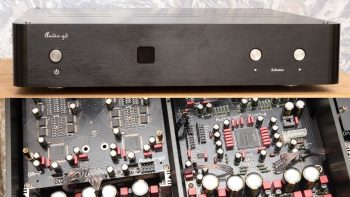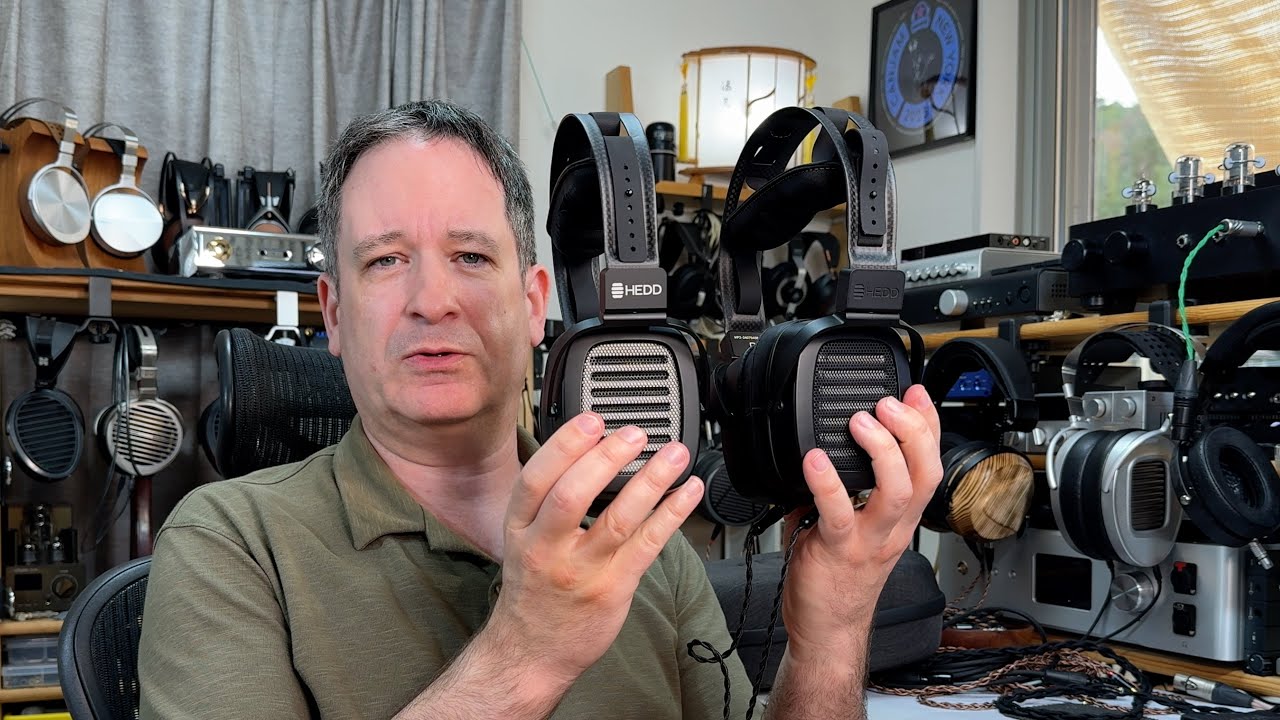Around a year ago Audio-gd announced the R2R 7, the first new discrete ladder DAC flagship from Audio-gd. With the previous flagships using the now discontinued PCM1704UK R2R DAC chip, the new flagship DAC from the Chinese company uses double-sided resistor ladder boards with switches, error correction provided by multiple on-board FPGAs.
Since the announcement much has changed. As well as changes to the inputs, two different firmware versions are available – the default “smooth” version, and the more lively “accurate” version, which increases the accuracy of the output of the digital processors.
In addition to that, the USB input was updated, first with isolation, and now with a dedicated power supply.
Alongside the features that can be turned on and off, the changes made reviewing the R2R 7 quite a challenge. As soon as you covered one thing, someone would suggest a tweak or change to settings or source and you’d be back again listening for subtle differences.
The main digital processor is still an Altera Cyclone IV, situated on the centre digital board, however even S/PDIF processing has been moved to programmed FPGAs. 11 processors in all reside in the R2R 7, making for some serious computing power.
How it adds up in terms of sound was another matter, and not a simple one at that.

The R2R 7 has 6 inputs, switchable from the front panel. The current options include 2x S/PDIF (with one optionally being AES/EBU), optical, 2x I2S (HDMI and RJ45) and USB. The USB now includes isolation and its own power supply. My original unit had neither, so since the maximum options for input are only available from I2S and USB, I stuck with USB via an iFi iUSB 3.0 for most of the review.
The dual I2S inputs recognise that no matter how much Kingwa improves on the quality of the inputs, many customers want to use a separate, high-quality transport of their own construction. I noticed significant performance differences between the inputs.
By default, the R2R 7 uses an 8x oversampling FIR, with no PLL or dithering used. However inside the DAC, via jumpers it is possible to turn on the PLL and dithering (recommended by myself and others) and set the oversampling to 4x, 2x, or even off altogether. In pure Non-Oversampling (NOS) mode, three types are available, with the 3rd version the highest quality, but the other two, less accurate versions available if required.
To add to the complexity, Kingwa contacted me to ask if I’d like to try firmware that sets the output of the DSP to be more accurate. It requires that a member of his staff remote-access your computer to run the firmware upgrade. I suggested that Kingwa implement some means of using a jumper to switch between modes as to change them, you have to switch off, connect, switch on and flash the DAC each time.
For the sake of simplicity, we’re calling the original software the “smooth” version, and the other, optional firmware the “accurate” version. This leaves the R2R 7 with an incredible combinations of options possible, compounded when you can get high-quality up-sampling software such as Audivana Plus in the mix.

The Focal Utopias had just arrived. I’d been waiting for them to more carefully compare the R2R 7 with Schiit Audio’s Yggdrasil. However, even using the best recordings I have, I can’t tell definitively which DAC is which plugged into the inputs of the Studio Six with most music. This using either USB to both (and Roon) or Audio-gd’s now discontinued DI-U8 with S/PDIF and Audirvana. The latter set-up, not using the built-in USB receivers of the DACs, sounded a bit nicer to me.
Picking as much complex music with a detailed soundstage as possible, I managed to guess correctly which DAC was which, the Yggdrasil still sounding very marginally more spacious and the R2R 7 a very tiny bit more closed-in. We’re talking barely perceptible differences though. This took effort I don’t want to repeat though! It might show up better on a proper speaker rig.
With the R2R 7 having been left on now for some weeks, any changes in the sound had settled, so it was time for some more critical listening. This was almost a difficult task due as every time I started listening to music with it I became too engaged with track being played!
Typically Audio-gd’s flagship DACs tended to be a bit on the warm side. Some people found the sound to be a bit imprecise, especially with the bass. It is particularly this problem which I didn’t hear from the R2R 7. I was careful to compare the bass to that from the Yggdrasil, and I felt for the first time that the closed-form filter didn’t provide the advantage that it had versus other DACs.

I tried the non-oversampling mode that is available by placing one of the included jumpers inside the unit. However with CD-quality music the sound just became vague and ill-defined. I experimented with up-sampling via Audirvana in this mode. Trying the DSD up-sampling modes, the music sounded strange and unnatural, so I quickly gave up that idea.
I tried a few experiments with regular up-sampling to 352.8 or 384k, using the 2x/4x setting in Audirvana Plus. With settings that emulate a linear phase filter (more or less all the sliders to the right) I felt that the music was a bit more precise, noticeable on songs such as Hollow Talk (Choir of Young Believers) where the background sounds and subtle details of the instruments were more audible.
Once it became apparent that the PLL and dithering (necessary to deal with quantisation distortion) were off, putting them on seemed to clear up the sound a bit, so I left them on for the duration of my time with the DAC.

The “accurate” firmware, given that I can’t quickly A/B between them, seems to increase the precision of each note, but with the loss of the “organic” enjoyment that an R2R DAC can provide. It would be very interesting to see measurements with the “accurate” firmware to see if the very low-level harmonic distortion is consequently lower.
The “accurate” firmware was more fussy with input quality. If I wanted a pleasant listen, a good transport was needed, either my Singxer F-1, though in the end the iFi iUSB 3.0 to the original USB input did very well. However the rewards, once the PLL and dithering were engaged were fantastic. With the slightly smooth, yet dynamic Soundaware P1 and Focal Utopias, listening was pure pleasure, reminding me much of the $100k Brise system I had auditioned at the Tokyo headphone festival.
Whereas with the smooth firmware, the Schiit Yggdrasil seemed somewhat dry in comparison, with the accurate firmware, the R2R 7 was the lively DAC and the Yggdrasil more laid-back, with possibly still a tiny bit more very-low-level detail.
Chord’s Hugo 2, fed via the iUSB or Schiit Wyrd still tops both, especially given an amp isn’t needed for most headphones, as it shows the soundstage of good 2-channel recordings with an uncannily good sense of depth and can extract the subtle warbles in the decay of guitar notes from Friday Night in San Francisco, and the subtle harmonic decay of piano notes from Horowitz in Moscow more so than the other DACs.
The new iFi Pro iDSD arrived after I shot the video and before I finished the written review, so before I sent the R2R 7 off I spent a bit of time comparing them. The R2R 7 was the sweeter DAC to listen with, the Pro iDSD, being almost, but not quite Chord-like in accuracy, revealing a very slight touch of what I call wood-like character of the Burr Brown DACs, even with the Gibbs Transient Optimised filter and Tube+ engaged.
What was ultimately apparent to me was that, set up carefully and switched on for a couple hours at least for best results, the R2R 7 can be an incredibly rewarding DAC to listen with. While it might sacrifice a tiny bit of detail compared to, say, the Hugo 2, instead it rewards with incredibly pleasurable listening.
On its last day here I connected it to the Audiovalve Solaris, which I have been using primarily with HiFiMan’s Susvaras, and the match made for wonderful day of listening.
Music Impressions
Set-up: Filtered USB input from Mac Mini; Master 9 via ACSS to Susvara, volume at 57-60; Accurate Firmware + NOS mode 3 or oversampling mode.
Restless Sinner – Black Rebel Motorcycle Club
The vocals and guitar jump out sharply from the centre of the audio image. It’s a very intense presentation, if the imaging is somewhat narrow. I feel that the sound is a bit distorted.
Oversampling mode: The soundstage widens and the overall precision increases. The presentation comes across as more “ruthless” than “intense”.
The Rifle’s Spiral – The Shins
Accurate mode pushes this right in your face. I don’t feel any benefit of NOS mode, which just seems to narrow the soundstage to no benefit.
Forever My Friend – Ray LaMontagne
I’m starting to suspect that accurate mode is too much of a good thing when listening to less than excellent recordings, as in Accurate/oversampling mode this album comes across in a way that is more mellow than the previous tracks. Ray’s voice, as well as instruments seem to site more in the background, giving a more relaxed presentation.
I thought that this was a good time to switch to a different input and so I moved to using my Raspberry Pi (DietPi) to iUSB 3.0 to Singxer F-1 set-up. I grouped the zones so I could compare them by switching inputs.
Going back through the previous tracks, the F-1 set-up sounds more mellow and less harsh. It’s very apparent switching inputs in the middle of a song. It doesn’t stop revealing the less than perfect nature of The Shins’ album, but seems to bring out a touch more of what is in the Ray LaMontagne album.
Every Heart – Acoustic Junction
With the volume up this high, a bit more than the level I usually listen at, this is still a bit too intense in accurate mode, possibly due to it being a lossy track via TIDAL.
As a comparison I played the tracks again through the Yggdrasil via a WaveIO board for input (in lieu of the fact that I don’t have a Gen 5 USB board yet).
The more mellow, yet precise impression the Yggdrasil gives was readily apparent. It makes the more intense/compressed tracks a bit more bearable.
If I feed the Combo 384 Amanero in the R2R 7 via the iUSB 3.0/DietPi set-up (Accurate FW in OS mode) the sound quality hit a fantastic sweet-spot of smoothness versus dynamics. It will be interesting to find out if the new isolated Amanero board has a similar effect to the iUSB 3.0.
Set-up: Combo 384 Amanero via iUSB 3.0/DietPi; Master 9 via ACSS to Susvara, volume at 57-60; Default Firmware.
For years we’ve mucked around with jumper and other settings and in the end, Kingwa’s defaults seem to be right every time. It’s much this way with the default set-up of the R2R 7, excepting that a better power supply and signal for the in-built USB helps. Again, this is without the newer isolated USB that is available.
The Shins, which could be harsh and too aggressive with the “accurate” firmware has a pleasant smoothness, and we aren’t treated to all that is wrong with the recording as before.
Revolutionary Kind – Gomez
The subtle harmonic richness which defines a typical resistor-ladder DAC makes this track deliciously pleasant to listen to without having to engage NOS mode.
Forever My Friend – Ray LaMontagne
This track can sound a bit dry on the Yggdrasil, but sounds rich and makes you want to move out of the R2R 7. I don’t know if it is firmware differences, but at what seemed like a bit too loud a volume (60 on the Master 9 via ACSS and with the Susvara) for me when using the accurate firmware now seems just about right with the default one.













